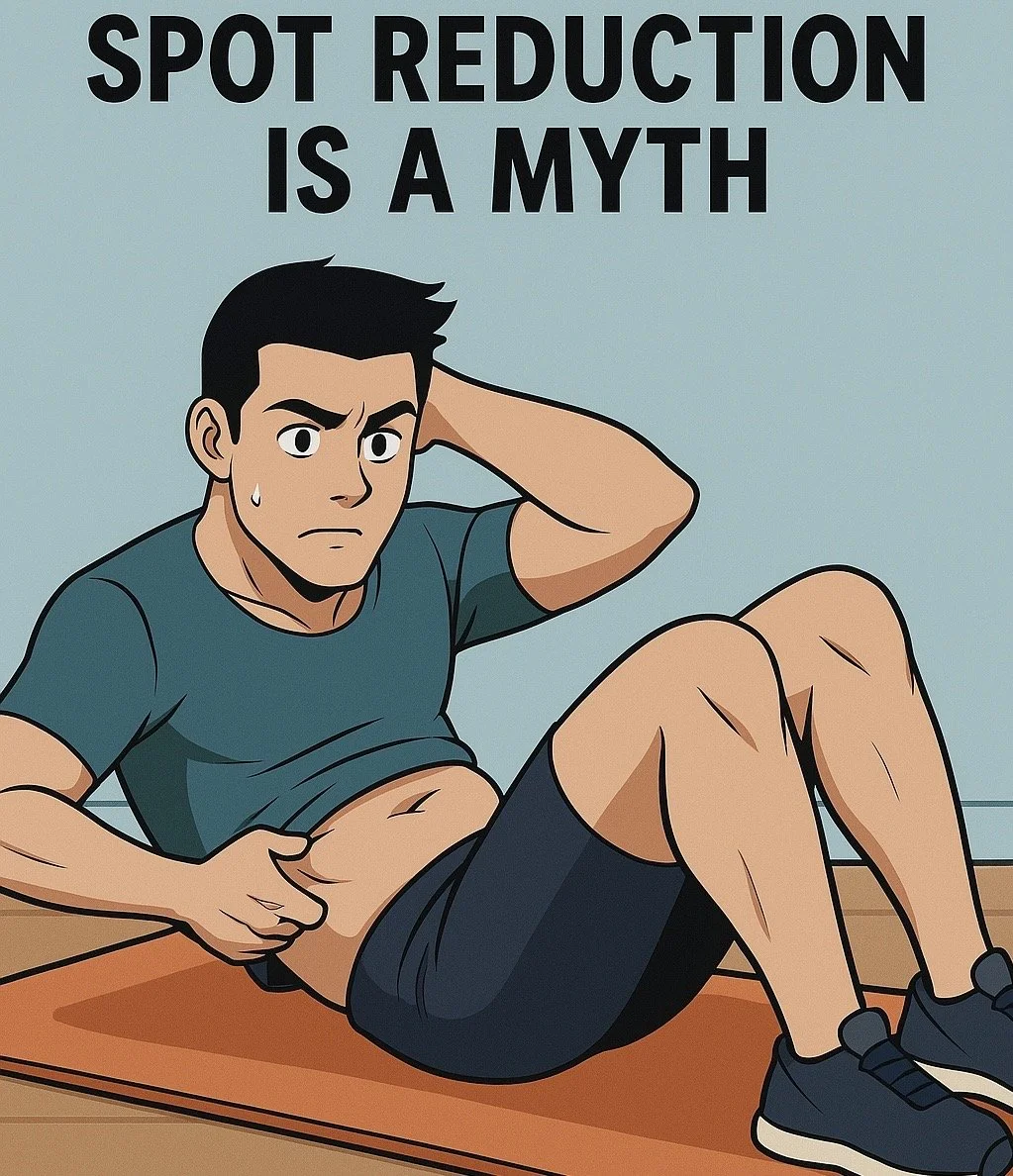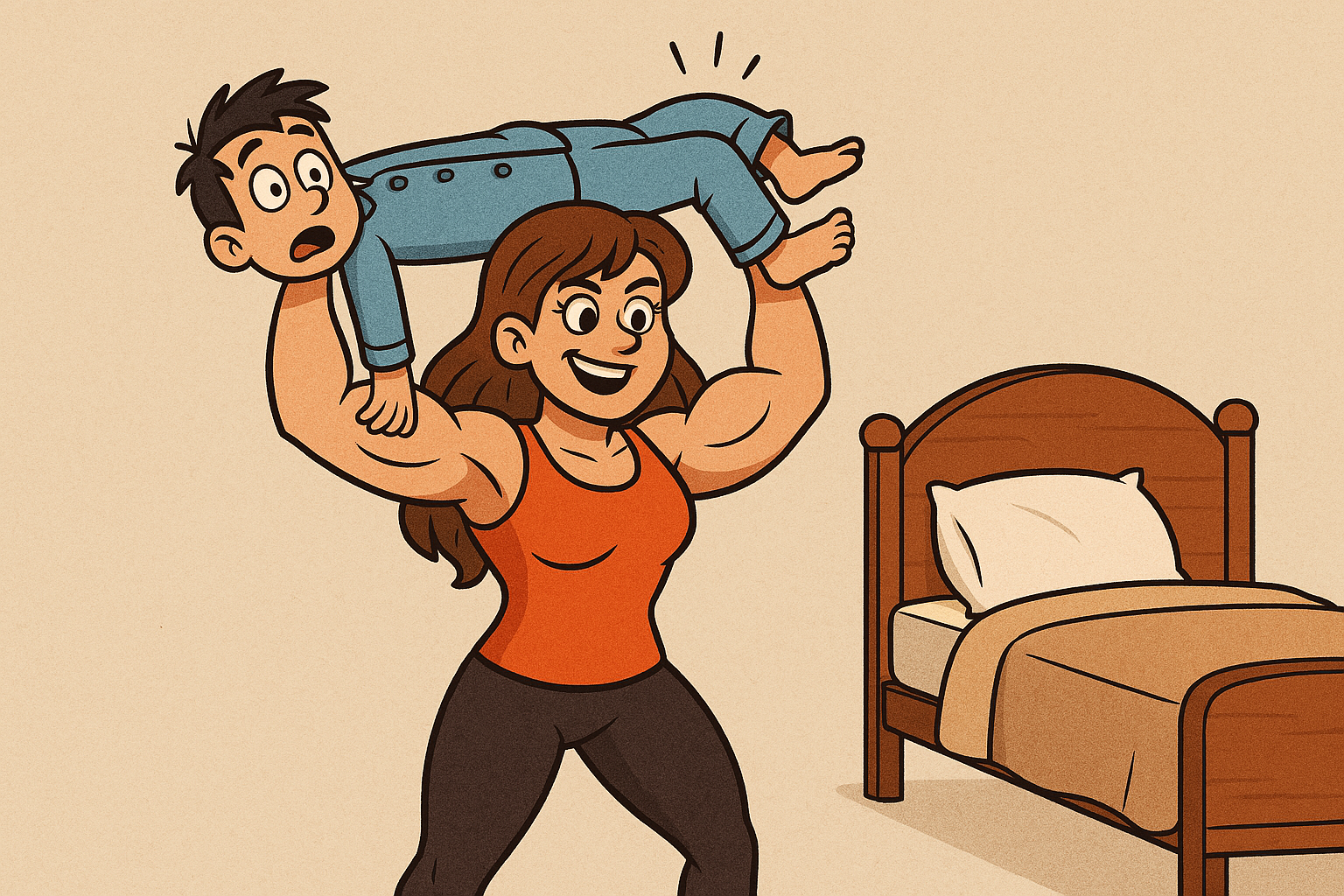10 Weightlifting Myths That Need to Go!
If I do these ab routines, I’ll lose belly fat!
I wish this was true! But unfortunately we are not able to choose where we lose fat from our body (also known as spot reduction).
If you do train your abs to reduce your belly fat, the outcome would be an increase in muscle size of your abdominal muscles. Some fat loss can occur in places if you are increasing the amount of exercising you do by performing said ab routines. However, it’s your genetics that decides where the fat will be lost.
Do you want to actually lose belly fat? You will have to create a calorie deficit by either decreasing the amount of calories you consume, or increasing the amount of exercise you do.
For more information and tips on how to do this, follow this article. Tired of reading how to and just want help? Join my coaching programme for 1 on 1 coaching with a money back guarantee if you don’t like the results!
2. I don’t want to go to the gym because I’ll get too bulky!
Crazy story, I took my partner to the gym with me. To my shock, the next day I woke up to the motion of her overhead pressing me with her new 20 inch arms. You can probably tell that was a joke, you’re not going to wake up looking like Arnold Schwarzenegger, muscle gain is a very slow process for men and women. I hear, “I don’t want to get too big” a lot. Trust me, most men weight training have been trying to get "‘too big’ for years!
As a beginner you will experience the most amount of muscle gain at the start of your lifting life as long as you are training, eating and sleeping well. Once you are happy with the amount of muscle you have, you can reduce the amount of training you do to maintain your physique.
3. If I stop my muscle will turn into fat
Muscle tissue and fat are completely separate and it is impossible for any muscle to change in to fat. The reason this myth may have started could be because when you stop resistance training, your muscles slowly reduce in size, and because you are now doing less exercise, your body will naturally store more fat if you’re now in a calorie surplus. So no need to worry, you won’t go from muscle bound to Mr. Blobby.
4. I want to stay slim so I should do cardio instead
Whilst it is correct that cardio generally burn more calories than resistance training, long term resistance training is will generally be a better choice. I go into more detail on this in this article. In short, the more muscle you have the more calories your body burns daily. This is because muscle tissue requires more energy to preserve than fat tissue does.
It’s estimated one pound of muscle burns between 5-10 extra calories per day. For our example lets call it 7. If you gained 15lbs of muscle, you are burning an extra 105 calories a day doing nothing. Doesn’t sound like much right? Add that up over the week and thats 735 calories. Now that sticky toffee pudding will be guilt free!
Of course you should still do some cardio for your (heart health). And if you love cardio, that’s great!
5. If I lift heavy weights I’ll lose my flexibility
Training with proper form through a full range of motion not only prevents loss of flexibility but can actively enhance it. When you perform exercises that stretch the muscle under tension, you are effectively elongating the muscle fibers while they are loaded. This type of dynamic stretch differs from traditional static stretching, which typically involves holding a position for 30 to 60 seconds. Instead, resistance training incorporates a controlled stretch throughout the movement, promoting greater muscle pliability and joint mobility.
Recent research supports this concept, demonstrating that resistance exercises performed with full range of motion contribute significantly to improving flexibility. Therefore, by focusing on technique and ensuring muscles are loaded through their entire movement path, you can maintain or even increase flexibility while building strength—offering the dual benefit of enhanced performance and injury prevention.
6. I don’t want to go to the gym every day to get results.
Although Hollywood may make out that this is the case. It’s not. You don’t need to go every day for 2 hours like The Rock. As a beginner, you can make very good progress lifting weights twice a week for 45-60 minutes a session.
Three, or four times is generally better and you will be able to see results faster, but starting at twice is absolutely fine. For the majority of my time lifting, I will go 4 times a week and each session is usually 45 minutes. That’s only 3 hours per week working out. When you think about how much time people spend on their phone per day, it’s really nothing in comparison.
If you would like a bespoke program hit me up!
7. No pain no gain!
The phrase "no pain, no gain" has been drilled into gym-goers for decades, but it’s actually a myth when it comes to effective training. You don’t need to suffer through agony to see results—progress comes from consistency, good technique, and listening to your body. Sure, you might experience DOMS (Delayed Onset Muscle Soreness) the day after a workout, but that’s just your muscles giving you a little nudge, not a call for emergency services. Think of it as your muscles’ version of a polite “hello” rather than a thrashing insult. Besides, after a while, you might find yourself actually enjoying the gentle ache—the only kind of pain where you hope it turns up like an overenthusiastic neighbour. So, skip the pain and focus on smart training; gains don’t demand torture chambers.
8. I’m a woman, I can’t really build any muscle.
Although you may think this because men look a lot more muscular than women, we both have the ability to put on muscle at a very similar rate. It looks like men are able to put on much larger amounts of muscle because men have a much larger amount of baseline muscle mass compared to a women, especially in their upper body. So if you’re a woman thinking what is the point, don’t be discouraged. Over time you will start to build muscle and strength just like any man would.
9. I’m too old for weights
Weightlifting for older people can be very helpful. I would never recommend jumping straight in training to failure full range of motion but I would recommend that as long as your doctor doesn’t advise you against any resistance training for health reasons, to give it a go. Having extra strength as you get older can be beneficial in numerous ways. When you get older your muscles atrophy (get smaller) and you begin to lose a lot of strength. Keeping us with just a basic amount of weight training can really help slow this process down.
Another plus that your bone density will be greater, giving you less chance of breaking a bone when you fall.
10. I don’t want to hurt my joints
Whilst injuries can happen in at any time, resistance training actually helps your joints by slowly strengthening your ligaments and tendons. Rather than hurting and damaging them, you’re helping them.
When you train, your muscles will strengthen at a faster rate than your ligaments and tendons. Make sure you’re using proper form on your exercises and you will reduce the risk of injury.
If your joints are hurting during training, you should see a physiotherapist.

